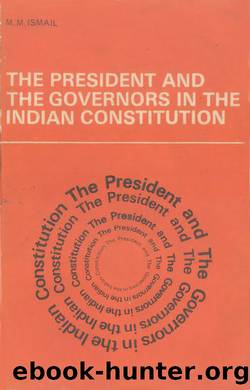The President and the Governors in the Indian Constitution by M. M. Ismail

Author:M. M. Ismail
Language: eng
Format: azw3
Tags: The President and the Governors in the Indian Constitution
Published: 2018-08-07T16:00:00+00:00
Thus, from the very beginning Dr. Rajendra Prasad had been raising this question repeatedly. In view of this Mr. Granville Austin was less than fair to Dr. Rajendra Prasad when he stated that his (Mr. Prasadâs) interest in this question was certainly more than academic. This is what he observed:
âPrasadâs interest in the extent of presidential power was almost certainly more than academic. It would have been unusual if there had not been speculation about who the first President of India would be.â46
However, even he admits that it is Mr. Prasadâs enquiries to the Constitutional Adviser that led to the proposal to introduce an Instrument of Instructions. Mr. Austin observed:
âDespite the honesty of his motives, it may have been Prasadâs inquiries to Rau that led the Drafting Commitee during the summer of 1948 to recommend including in the Constitution an Instrument of Instructions definitively limiting the Presidentâs power.â47
Again, referring to the deletion of clause 5-a of Article 62, the non-inclusion of Schedule III-A and deletion of Schedule IV in the Draft Constitution, he stated:
âThe Assembly was never in so many words given the reasons. Ambedkar was in the unenviable position of having to support the withdrawal of the Instruments from the Constitution after his own committee had put them there. It is through his speeches that we must attempt to understand the Assemblyâs change of mind.â48
After referring to Mr. H. V. Kamathâs question and Dr. Ambedkarâs reply already mentioned above, Mr. Austin proceeds to state:
âFrom this, one is forced to deduce that Ambedkar and the members of the Drafting Committee, perhaps under pressure from Nehru or Patel, had come to the conclusion that the written provisions of a non-justiciable Instrument of Instructions and the tacit conventions of cabinet government had equal value: both were legally unenforceable, but both provided a mechanism by which the Legislature could control the Executive; and of the two, conventions were the tidiest and the simplest way of limiting Executive authority.
Not all the members of the Assembly were happy about the removal of the written conventions, although Ambedkarâs categorical statement to Kamath had quieted most fears. Ayyar attempted to soothe the suspicions that remained. He warned the Assembly that including a partial list of conventions in the Constitution might cause the Executive to suppose that all powers not specifically denied them were theirs, and the result, he said, could be conflict between the Executive and the Legislature. Ayyar concurred with Ambedkar that a President who did not heed the advice of his Ministers would in fact be thwarting the will of Parliament, for which he could be impeached.
With the Instruments of Instructions gone, the protection of Parliamentary government in India was left to convention, to the vigilance of Parliament, and ultimately, âto the will of that power which........... is the true political sovereign of the Stateâthe majority of the electors or............the nationâ.â49
Download
This site does not store any files on its server. We only index and link to content provided by other sites. Please contact the content providers to delete copyright contents if any and email us, we'll remove relevant links or contents immediately.
| Anthropology | Archaeology |
| Philosophy | Politics & Government |
| Social Sciences | Sociology |
| Women's Studies |
The Secret History by Donna Tartt(16606)
The Social Justice Warrior Handbook by Lisa De Pasquale(11485)
Thirteen Reasons Why by Jay Asher(7780)
This Is How You Lose Her by Junot Diaz(5753)
Weapons of Math Destruction by Cathy O'Neil(5029)
Zero to One by Peter Thiel(4816)
The Myth of the Strong Leader by Archie Brown(4785)
Promise Me, Dad by Joe Biden(4440)
Stone's Rules by Roger Stone(4412)
Beartown by Fredrik Backman(4403)
How Democracies Die by Steven Levitsky & Daniel Ziblatt(4392)
The Fire Next Time by James Baldwin(4336)
100 Deadly Skills by Clint Emerson(4070)
A Higher Loyalty: Truth, Lies, and Leadership by James Comey(4024)
Rise and Kill First by Ronen Bergman(4008)
The David Icke Guide to the Global Conspiracy (and how to end it) by David Icke(3875)
The Farm by Tom Rob Smith(3869)
Secrecy World by Jake Bernstein(3773)
The Doomsday Machine by Daniel Ellsberg(3725)
